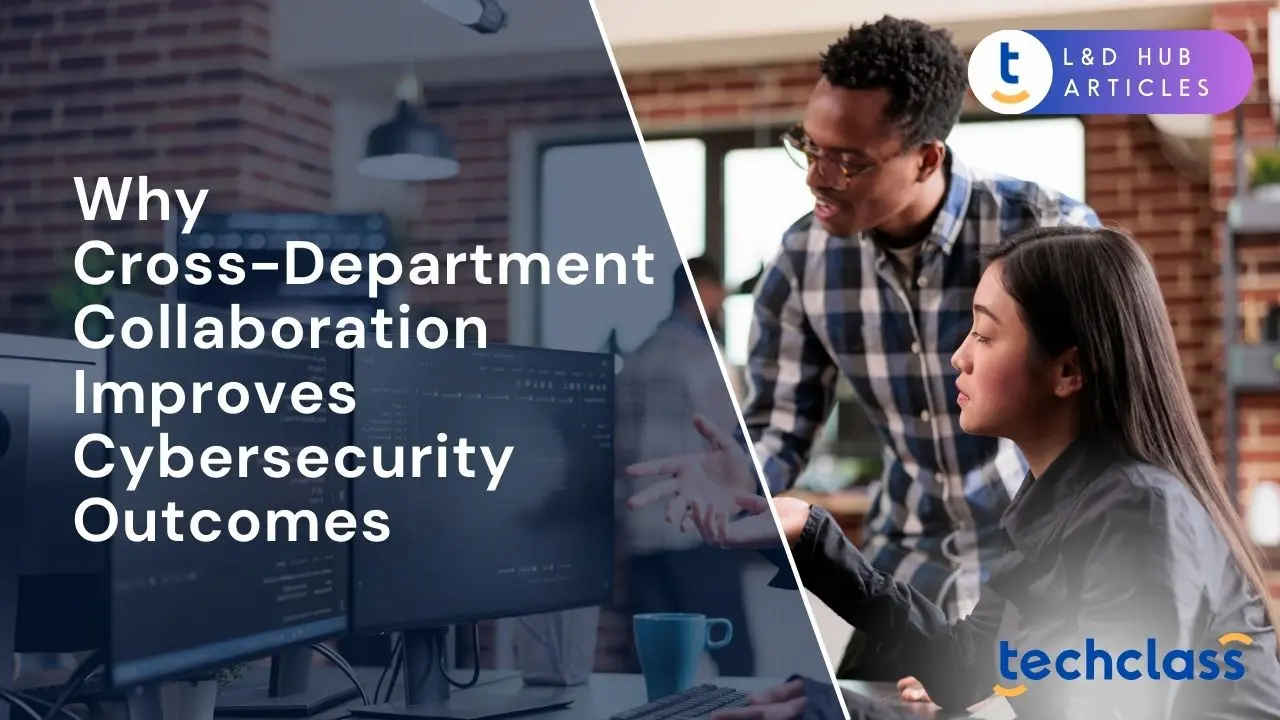Cybersecurity Is a Team Sport in the Digital Age
In an era of relentless cyber threats, safeguarding an organization is no longer solely the IT department’s job. Cybersecurity has become a team sport, every department and employee has a role to play. Lack of collaboration is a known business risk: 86% of executives cite ineffective teamwork and communication as a leading cause of workplace failures. This holds especially true in security, where one weak link can expose the whole company. Most employees (75%) already recognize that teamwork is essential, yet 39% feel their organizations fall short in this area. In other words, while leaders know that security is everyone’s responsibility, many companies remain stuck in siloed mindsets. This article explores why breaking down departmental silos and fostering cross-functional collaboration leads to better cybersecurity outcomes, and how enterprise leaders, from HR to operations, can cultivate a culture of shared defense.
The Risks of Working in Silos
Departments that operate in isolation (“silos”) inadvertently create blind spots in an organization’s security. You can’t secure what you can’t see, and silos breed vulnerabilities. For example, one survey found that 60% of security software users analyze less than 40% of their log data, leaving dangerous gaps in threat visibility. If the IT security team isn’t regularly communicating with other departments, they may be unaware of shadow IT systems, unusual network behaviors, or business process changes that introduce new risks.
Siloed workflows also lead to misaligned priorities. Business leaders might not fully understand technical cyber risks, and security teams might not grasp business constraints. This disconnect can be perilous. A notable analysis of the massive Yahoo data breach of 2016 suggested that although Yahoo had world-class security professionals, key decision-makers didn’t fully appreciate the cybersecurity risks, indicating a breakdown in collaboration and shared understanding. In large enterprises, it’s common that security warnings go unheeded by other departments until it’s too late. Without cross-departmental dialogue, critical updates or policies (like patching software or changing passwords) may be ignored or delayed because their importance wasn’t clearly communicated in business terms.
Finally, silos cultivate the mindset that “cybersecurity is someone else’s problem.” Non-IT staff might assume security is solely IT’s responsibility, leading to negligence in basic practices. Phishing emails, weak passwords, and other human errors often slip through cracks when employees aren’t engaged partners in protection. In reality, human error remains the most persistent cybersecurity threat, 74% of breaches involve the human element (errors, phishing, misuse of credentials, etc.). When departments don’t collaborate, organizations fail to leverage their best defense: an alert, informed workforce. In short, working in silos leaves companies flying blind on cyber risks and prone to communication breakdowns that attackers can exploit.
Key Benefits of Cross-Department Collaboration
Effective cross-department collaboration can dramatically strengthen an organization’s cybersecurity posture. By uniting diverse teams around a common security mission, companies gain:
- Comprehensive Risk Visibility: Collaboration breaks down information barriers between teams, giving security staff a 360-degree view of the organization. IT may monitor network logs, but frontline departments see day-to-day anomalies (finance noticing strange payment requests, HR spotting suspicious behavior, etc.). When these insights are shared, threats are spotted earlier. In fact, closer collaboration boosts network visibility and leads to more effective defenses. Conversely, siloed teams often overlook risks outside their narrow view. A collaborative approach ensures no part of the business is “out of sight, out of mind” to security.
- Fewer Human Errors and Policy Violations: Many security breaches stem from mistakes or risky user behaviors. Cross-department teamwork helps address this by making security policies more practical and better understood across the organization. When security professionals work closely with other departments, they can tailor guidelines to fit day-to-day workflows, reducing frustration-driven workarounds. For example, shadow IT (use of unauthorized apps) often arises when strict tools hinder productivity. By understanding other teams’ needs, security can offer safer alternatives that people actually want to use. Collaboration also reinforces training, colleagues remind each other of best practices, and security awareness becomes ingrained. All of this helps shrink the “human error” attack surface. As evidence, research shows that the human element plays a role in 3 out of 4 breaches, so empowering people through collaboration is key. Simply put, when every department is educated and heard, employees are far less likely to make careless mistakes that hackers prey on. Regular, organization-wide Cybersecurity Training initiatives can strengthen these collaborative efforts, ensuring every department understands its role in protecting data and reducing human-driven risks.
- Faster Incident Detection and Response: A cyber incident in one corner of the company can rapidly impact the whole enterprise, response speed is critical. Cross-department coordination ensures that when an incident occurs, information flows quickly and the right people take action. Collaborative incident response plans define clear interdepartmental roles ahead of time (e.g. IT containing the breach, Legal handling notifications, HR managing internal comms). This preparation prevents the delays and confusion that often plague siloed organizations during a crisis. According to experts, encouraging collaboration before an incident leads to “greater success sharing information during an incident” because teams already have working relationships and trust. In practice, when everyone from executives to analysts is on the same page, potential breaches are spotted sooner and contained faster. Additionally, spreading security responsibilities lightens the load on the IT team. If non-IT staff resolve minor issues themselves (with proper training), the security team can focus on critical threats. This reduces burnout and alert fatigue, a problem so severe that it contributes to analyst turnover in 62% of organizations. By collaborating, companies not only react to incidents more efficiently, they also create a more sustainable defense workflow.
- A Strong Security Culture and Shared Ownership: When every department actively participates in cybersecurity, it cultivates an organization-wide security mindset. Collaboration builds trust and empathy among teams, allowing a cyber-secure culture to grow where people feel accountable for protecting the company. Instead of an “us vs. them” dynamic between security and other staff, everyone becomes part of the “us.” Employees in all roles are more likely to speak up about potential threats or report mistakes early when they know they won’t be blamed or ignored. Regular cross-functional meetings and joint trainings signal that security is a collective mission. Over time, this shared responsibility yields more vigilant, proactive behavior at every level, from interns up to the C-suite. For example, an employee in marketing who might have shrugged off a suspicious email in the past will now report it, knowing that security is a company priority. Collaboration embeds security awareness into daily operations and decision-making, so safe practices become second nature. The result is a resilient culture where people are the strongest link, not the weakest.
- Efficient Use of Resources and Easier Compliance: Unified efforts eliminate redundancy and improve resource allocation for security. When departments collaborate, they can pool tools, expertise, and budgets to address risks holistically rather than piecemeal. For instance, IT and finance can jointly evaluate cybersecurity investments for cost-effectiveness, ensuring money is spent where it truly reduces risk. Better communication also means security priorities align with business objectives, so critical initiatives get the funding and support they need. Moreover, cross-functional input simplifies compliance with security standards or regulations. Effective collaboration can reduce the time to implement frameworks like ISO 27001 by up to 40%, as teams coordinate on documentation and controls instead of each group struggling alone. One industry source also notes that organizations with cross-department participation have a 30% higher likelihood of maintaining continuous compliance with cybersecurity policies. In short, working together not only saves time and costs, it ensures your security measures and legal obligations don’t fall through the cracks. The business runs smoother when everyone rows in the same direction on security efforts.
Building a Collaborative Security Culture
Achieving these benefits requires intentional effort from leadership to break down barriers. Here are strategies enterprise leaders and HR professionals can use to foster cross-department collaboration in cybersecurity:
- Lead from the Top: Executive sponsorship is critical. Leaders should openly champion the message that security is a shared responsibility and back it up with actions. This could mean incorporating cybersecurity objectives into enterprise-wide goals and performance evaluations. When department heads themselves collaborate on security initiatives (for example, the CIO, HR director, and business managers working together on a phishing awareness program), it sets a powerful example. A top-down emphasis on teamwork will naturally “trickle down” through the organization. Make it clear that silo mentality is no longer acceptable by celebrating collaborative successes and holding teams accountable when they fail to coordinate.
- Form Cross-Functional Security Committees or Working Groups: Don’t leave cybersecurity planning and decision-making to IT alone. Create a committee with representatives from key departments, IT, HR, Finance, Operations, Legal, etc., to meet regularly about security issues. This group can discuss security policies, upcoming projects, incident post-mortems, and risk assessments from multiple viewpoints. By involving stakeholders early in security planning, you’ll get diverse perspectives and buy-in across the board. Members of the committee become security champions within their departments, spreading awareness and relaying feedback or concerns from their teams. Such structures formalize collaboration and ensure ongoing dialogue between otherwise disconnected units.
- Encourage Open Communication and Knowledge Sharing: Break the communication barriers by establishing channels for anyone to raise security questions or suggestions. This could be as simple as a dedicated Slack/Teams channel or an internal portal where employees can report suspicious activities and get advice. Emphasize that there are no stupid questions when it comes to security, a culture of openness can prevent incidents. Regular cross-training sessions are also useful: for example, IT can brief other teams on how to spot phishing emails or secure remote work setups, while other departments can educate IT about business processes. This two-way education builds mutual understanding. It’s also wise to tailor communication methods to avoid overload, perhaps use asynchronous forums or Q&A forms for non-urgent ideas, and reserve real-time alerts (texts, calls) for critical incidents. When communication is consistent and inclusive, collaboration becomes part of the workflow rather than an extra task.
- Remove Technical and Organizational Silos: Often, departments use separate tools or have incompatible systems that hinder information sharing. Investing in integrated platforms can unify workflows (for instance, using common project management or incident tracking software across departments). Even simple steps like granting security teams read-access to relevant business data, and vice versa, can improve visibility. Regular interdepartmental meetings or joint drills (e.g. cybersecurity tabletop exercises that include IT, business units, and executive teams) help break the ice and build familiarity. Organizational policies can reinforce this integration too, for example, require that any new tech project involves a security review with all stakeholders, not just IT. By weaving collaboration into processes and removing structural barriers, you ensure that no team is left isolated when addressing threats. Everyone should feel they’re on the same platform (both technically and figuratively) fighting the same fight.
- Align Security with Business Objectives: One major key to cross-department collaboration is framing cybersecurity in terms that resonate with each department. HR cares about protecting employee data, finance worries about fraud and financial loss, sales wants to keep client trust, and so on. Security leaders should translate technical risks into business context for each audience. When other departments see how strong cybersecurity supports their goals (and conversely, how breaches could derail those goals), they are more motivated to collaborate. For instance, demonstrating to Marketing that a cyber incident could damage brand reputation makes them eager to participate in preventive measures. Likewise, collaborating with HR on security training shows HR how it enhances workforce competency and culture. In every initiative, connect the dots: show how cross-functional security efforts enable smoother operations, compliance, customer trust, and ultimately the bottom line. This alignment turns cybersecurity from a technical obligation into a shared mission that adds value for all.
- Foster a Blame-Free, Learning Environment: Finally, cultivate an atmosphere where reporting problems or mistakes is encouraged, not punished. If an employee in one department clicks a phishing email, the goal should be to openly fix the issue and learn from it, not to shame the individual or scold their manager. Cyber incidents should be treated as organizational challenges, not individual failings. When people trust that they can speak up about near-misses or security concerns without backlash, collaboration naturally improves. Teams will proactively reach out to the security group with questions or for advice, heading off issues before they escalate. Consider implementing a “just culture” approach (borrowed from safety-critical industries like aviation and healthcare) in cybersecurity: focus on understanding why a mistake happened and how to prevent it, rather than zeroing in on who to blame. This philosophy builds trust between departments and the security function. Over time, employees become more security-conscious and willing to collaborate, knowing they are all on the same side, working towards a safer enterprise.
Final Thoughts: Toward a Unified Defense
In today’s threat-filled landscape, no department can afford to operate on an island. Cybersecurity is woven into every facet of modern business, from HR onboarding processes to finance systems to marketing campaigns. Cross-department collaboration transforms cybersecurity from a lone IT hurdle into a company-wide shield. By uniting people, processes, and technology across the organization, businesses create a unified defense that is far stronger than the sum of its parts. Communication improves, risks are spotted sooner, and employees at all levels take ownership of protecting the enterprise.
For HR professionals and business leaders, the takeaway is clear: fostering a collaborative security culture is not just an IT initiative but a strategic imperative. Encourage your teams to break down silos, share knowledge, and support one another in safeguarding the organization’s digital assets. The improvements in security outcomes, fewer breaches, faster responses, and a resilient workforce, will speak for themselves. Ultimately, cyber threats are constantly evolving, but a company that works together can adapt and withstand them. United we secure, divided we fall, by remembering this, enterprises can greatly improve their cybersecurity outcomes while also strengthening overall teamwork and trust.
FAQ
What are the main risks of working in silos for cybersecurity?
Working in silos creates blind spots, reduces threat visibility, and leads to misaligned priorities between departments. This lack of collaboration can result in overlooked vulnerabilities, ignored security warnings, and a culture where employees assume cybersecurity is only IT’s responsibility.
How does cross-department collaboration improve cybersecurity outcomes?
Collaboration enhances risk visibility, reduces human errors, speeds up incident response, builds a strong security culture, and ensures more efficient use of resources. Teams share insights, align security with business goals, and work together to maintain compliance.
Why is human error a significant cybersecurity risk?
Human error plays a role in 74% of breaches, often due to phishing, weak passwords, or misuse of credentials. Collaboration helps reduce these risks by improving training, making security policies more practical, and reinforcing best practices across teams.
What strategies can leaders use to build a collaborative security culture?
Leaders can champion security from the top, form cross-functional committees, encourage open communication, remove technical silos, align security with business goals, and create a blame-free environment to encourage reporting and knowledge sharing.
How can aligning security with business objectives encourage collaboration?
When cybersecurity is framed in terms that matter to each department, such as protecting employee data for HR or preventing fraud for finance, teams understand its value and are more motivated to collaborate on security initiatives.
References
- Salesforce Canada. How Soft Skills Are Crucial to Your Business. Salesforce Blog. https://www.salesforce.com/ca/blog/how-soft-skills-are-crucial-to-your-business/
- Verizon. 2023 Data Breach Investigations Report, Summary of Findings. Verizon Business.
https://www.verizon.com/business/en-nl/resources/reports/dbir/2023/summary-of-findings/ - Amos Z. Why Collaboration Is Essential for Cybersecurity Teams. ISA Global Cybersecurity Alliance Blog (Automation.com reprint). https://gca.isa.org/blog/why-collaboration-is-essential-for-cybersecurity-teams
- Onyxia. The Benefits of Cybersecurity Collaboration: Achieving a Unified and Strategic Approach. Onyxia Blog. https://www.onyxia.io/blog/the-benefits-of-cybersecurity-collaboration-achieving-a-unified-and-strategic-approach
- Cane T. How to Ensure Cross-Functional Collaboration When Implementing ISO 27001. ISMS.online. https://www.isms.online/iso-27001/how-to-ensure-cross-functional-collaboration-when-implementing-iso-27001/
- Castaldo C. A Case for Collaboration. United States Cybersecurity Magazine. https://www.uscybersecurity.net/csmag/a-case-for-collaboration/
Weekly Learning Highlights
Get the latest articles, expert tips, and exclusive updates in your inbox every week. No spam, just valuable learning and development resources.



.webp)